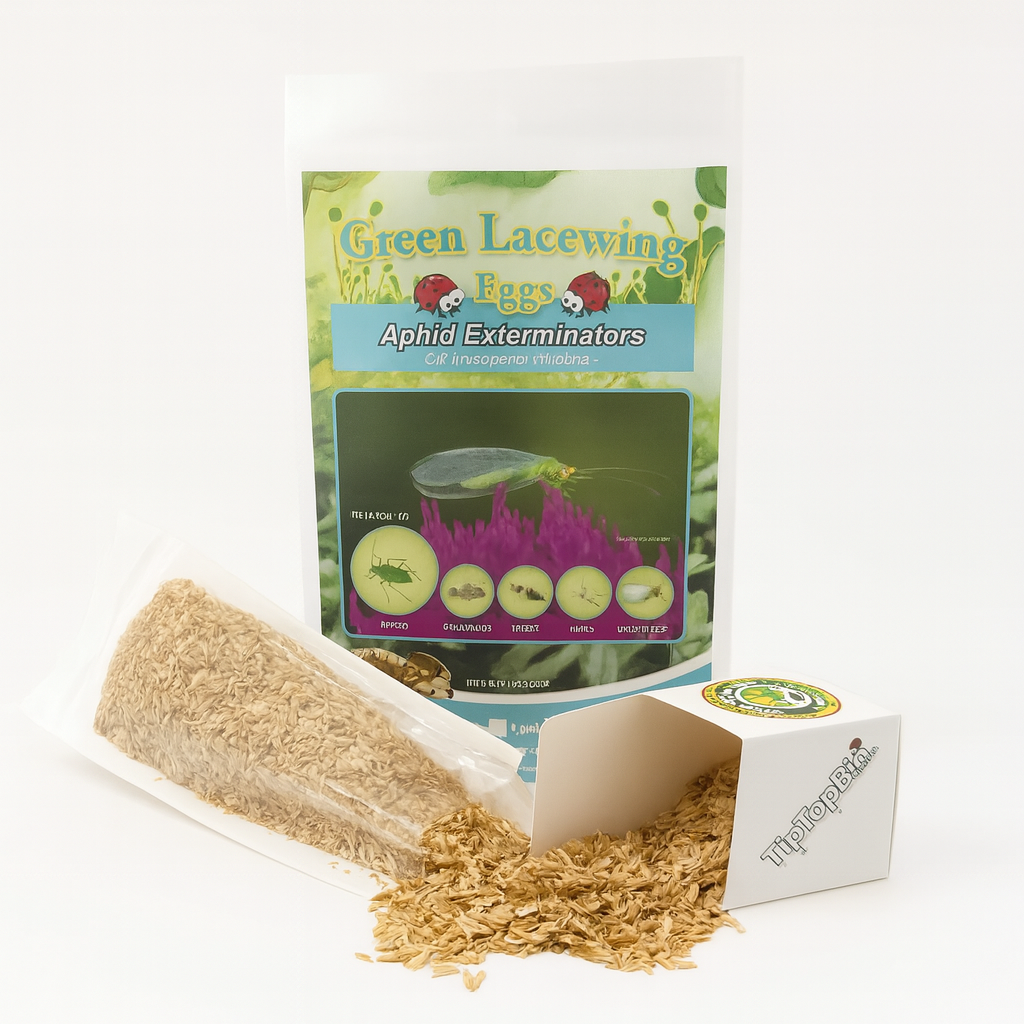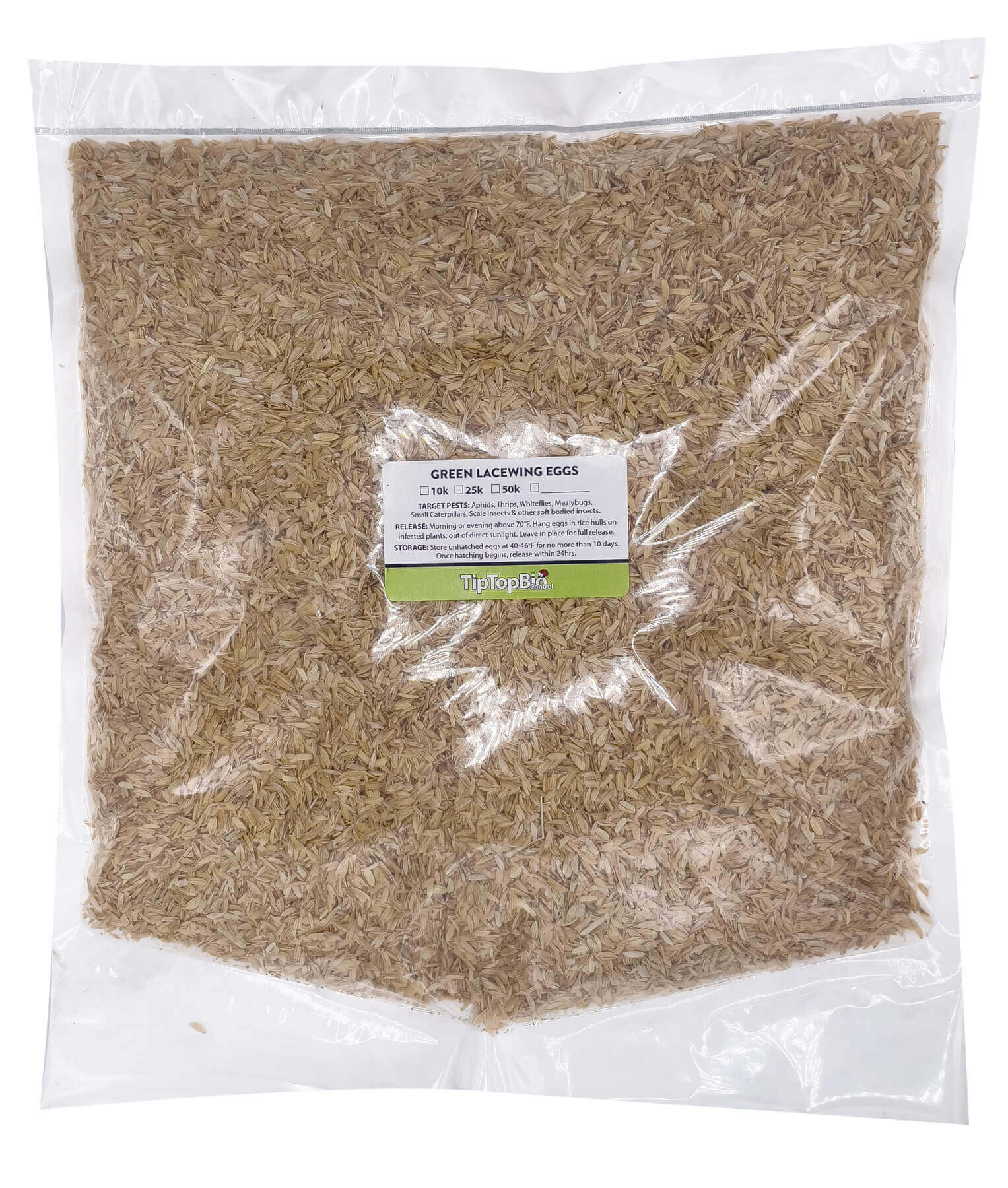Want to Stop Aphids Without Spraying? Let These Hatch First.
Sprays are short-term. Lacewing eggs are strategy.
If you’re done reapplying oils or watching pests rebound days after treatment, green lacewing eggs offer a better way forward. Each egg hatches into a fast-moving, soft-bodied-pest killer—a lacewing larva, nicknamed the “aphid lion.”
They hunt constantly for 2–4 weeks, targeting aphids, thrips, whiteflies, and more—without harming pollinators, plants, or beneficial soil life.
Green Lacewing Eggs
Chemical-Free Pest Suppression That Builds Over Time
Unlike instant-release larvae, lacewing eggs hatch slowly over several days, delivering a more measured, sustained release of predatory pressure.
That makes them ideal for:
-
Preventing outbreaks before they escalate
-
Following up after sprays or fast-acting predators
-
Scaling from small indoor grows to greenhouses and orchards
What They Treat
| Pest | Stage Targeted |
|---|---|
| Aphids | All life stages |
| Mealybugs | Crawlers and early nymphs |
| Thrips | Larvae and adults |
| Spider mites | Opportunistic feeders |
| Whiteflies | Eggs, nymphs, and adults |
| Other soft-bodied insects | Caterpillars, eggs, and more |
Note: Lacewing larvae are generalist predators—they’ll eat just about anything soft-bodied and small enough to catch.
Why Use Lacewing Eggs?
| Feature | What It Solves |
|---|---|
| Extended hatch window | Ongoing suppression without overloading the canopy |
| No sprays or residue | Perfect for organic and no-till systems |
| Hands-off scaling | Apply once, hatch over time |
| IPM-compatible | Stacks with cucumeris, Orius, or ladybugs |
| Safe | No impact on pollinators, pets, or plants |
If you’ve been looking for a non-spray option to control aphids or thrips, this is it.
How They Work
-
Eggs hatch in 2–7 days (timing depends on temperature)
-
Larvae begin feeding immediately—injecting digestive enzymes and sucking pests dry
-
Feeding continues for 2–4 weeks before pupation
-
Adults emerge, mate, and lay the next generation of eggs—if pest levels remain
How Many You Need
| Use Case | Rate |
|---|---|
| Preventative coverage | 1 egg per sq. ft. monthly |
| Active infestations | 1 egg per 3 sq. ft. weekly |
| Large-scale growing | 5,000–10,000 eggs per acre, adjusted based on crop density |
If you’re unsure, go heavier in high-density zones or areas with pest history.
Choose Your Format
| Format | Best For |
|---|---|
| Eggs in rice hulls | Use included hanging release boxes (great for larger spaces) |
| Eggs on cards | Hang directly near pest clusters (ideal for focused applications) |
Box Count Guide
-
1K–2.5K eggs = 5 boxes
-
5K = 10 boxes
-
10K = 15 boxes
Pro Tips
-
Introduce early—don’t wait for pest explosions
-
Avoid pesticides 7 days before and after release
-
Keep temperatures between 60–95°F and moderate humidity for best hatch rates
-
Add a Good Bug Diet if pest levels are low—gives larvae something to feed on while hunting ramps up
-
Works well as a follow-up to lacewing larvae, Orius, or ladybugs
Shipping & Storage
-
Ships live with fresh hatch timing
-
Store at 50–60°F for up to 14 days
-
Do not freeze or overheat
-
Use immediately after removing from cold
-
Allow up to 7 days for full hatch depending on conditions
FAQ
How does the Live Guarantee work?
We know how important it is for your mites to arrive healthy and ready to work. That’s why we offer a live arrival guarantee—with flexible options depending on when we hear from you:
- Let us know within 24 hours of delivery: We’ll gladly send a free replacement shipment.
- Let us know within 2–3 days of delivery: We can offer store credit to make things right.
- After 3 days from delivery: Because these are living organisms, we’re not able to offer replacements or credit beyond that window. By then, it’s harder to know what went wrong or whether shipping conditions were a factor.
We truly want your mites to succeed—so please open your package as soon as it arrives and check on them. If something doesn’t look right, don’t wait—reach out and we’ll take care of you.
Where are you located?
We have a number of different locations in NJ, Maine and Oregon. While we'd love to have you, we are not currently open to the public.
Can I call you?
We get it. Sometimes it's easier to talk to someone, and on a case by case basis we can try to figure it out. Unfortunately though, we're really not able to take calls—FGMN is a small nursery, and we're usually elbows-deep in plants or packing boxes. To make sure nothing gets missed (and everyone gets a timely reply), we keep all communication in writing.
Feel free to message us at info@fgmnnursery.com. We mostly respond quickly, but every once in awhile replies may take a day. Do follow-up if you don't hear in that time. We're human, we miss an email here or there.
Too Many Options?
We get it. Try our mite/insect matchmaking quiz and instantly get matched to the solutions you may need.
Our Live Delivery Guarantee
We stand behind every leaf and every mite. If your plant or predatory insects don’t arrive alive on the first delivery attempt, we’ll make it right.
Here’s what you need to know:
- Email us at info@fgmnnursery.com within 24 hours of delivery
- Include clear photos of the item and the shipping label
- Someone must be available to receive the package—plants and bugs don’t do well sitting in the sun, a mailbox, or the back of a delivery truck
For plants, we offer store credit if something goes wrong.
For predatory mites and beneficial insects, you’ll have the choice of a replacement shipment or store credit.
If you contact us after the 24-hour window, we may still be able to help—just know it’s handled case by case.
We pack with care, insulate when needed, and check the weather before shipping. But once it’s in transit, the fastest way to protect your order is to open it right away.
Mite Matters
The Hidden Weather That Shapes Plant and Predator Life
Invisible weather shapes every growing space. Warm air pools under lights, cool air settles near the floor, and in between, tiny predators decide where they’ll thrive. Learn how microclimates influence the balance between plants, pests, and the mites that keep them in check.
If Ladybugs Are Just Going to Fly Away, Why Use Them?
Most ladybugs don’t fly off out of spite — they leave when the environment isn’t right. Learn how temperature, humidity, and shelter affect whether they settle or scatter, and how to create the ideal setup that keeps them working where you need them most.
Where Did My Predatory Mites Go?
Released predatory mites but can’t see them anymore? Don’t panic. Their invisibility is exactly what makes them effective. Learn why they vanish, how they hunt pests out of sight, and why reapplying keeps your plants protected.











